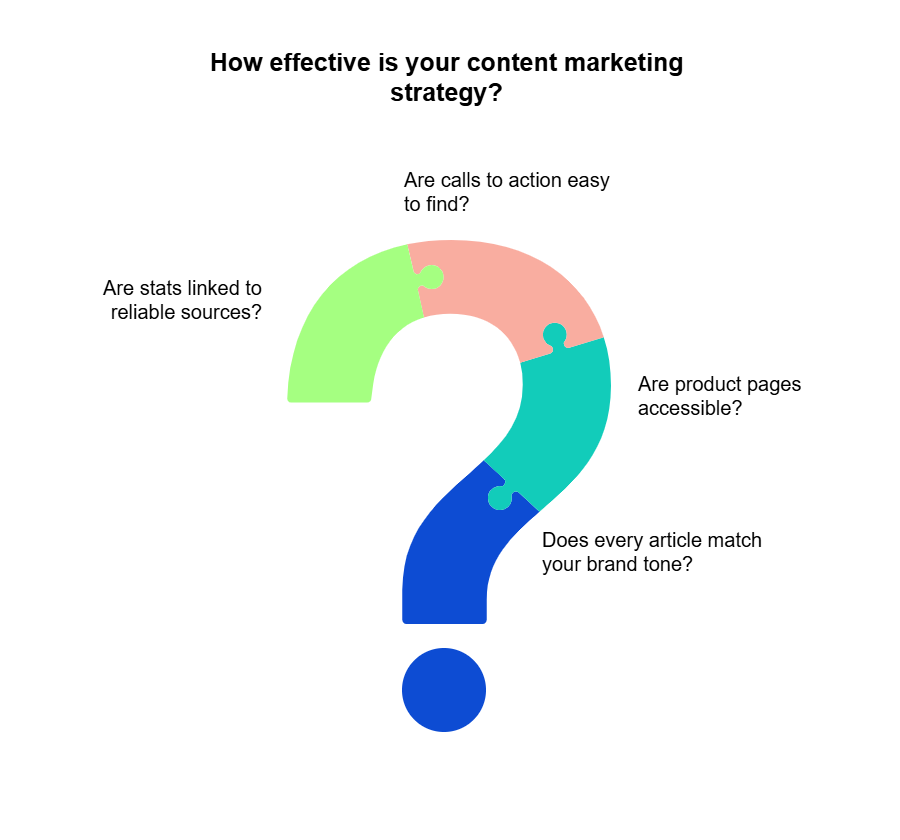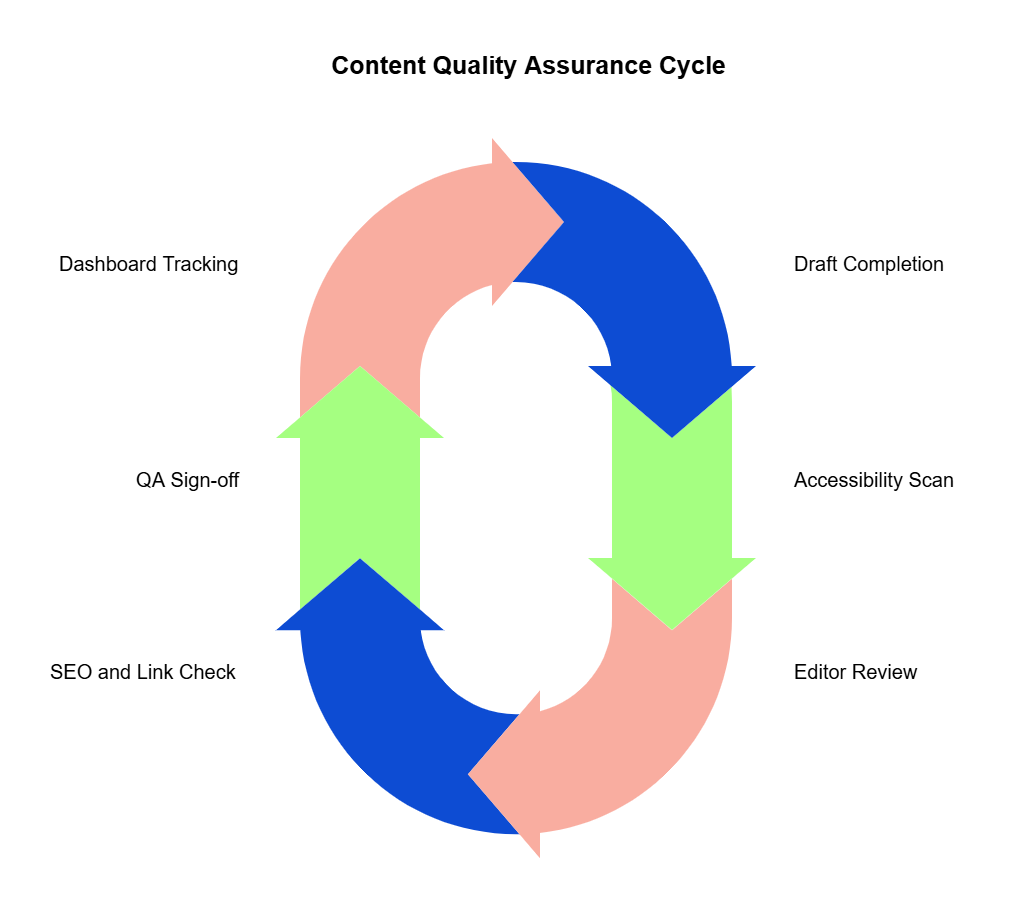Content drives your brand’s reputation, search performance, and customer trust. If you want your marketing to work, your content can’t just look good in a quick scan of individual assets. It must meet strict quality standard requirements, some of which aren’t visible or explicit, every time.
Most teams know this. But in practice, even seasoned digital marketers struggle to keep their content accurate, accessible, on-brand, and compliant at scale. Broken links slip through. Inconsistent messaging weakens trust. Missed accessibility checks create legal risk.
The result? Lost time, avoidable expenses, and frustrated teams.
Content quality standards solve this. They define exactly what “quality” means for your organization, and ensure every asset, page, blog post, and campaign meet the mark. When enforced well, quality standards boost organic traffic, reduce rework, and increase engagement. You spend less time putting out fires and more time being creative and strategic.
Quality standards also create the bridge between big-picture planning and everyday decisions. They turn strategy into concrete criteria for what gets published, what goes back for revision, and what your brand stands behind. If you want standards that stick, you need a shared definition of excellence that holds up under tight deadlines and high volumes.
Content strategy points you in the right direction; content quality standards determine if each piece measures up. Voice, accuracy, accessibility — these aren’t left to chance. They’re built, monitored, and protected by the standards applied in daily decisions.
What are content quality standards & why do they matter?
Your marketing team is responsible for hundreds of web pages and countless campaigns. Then the inevitable happens . . . one piece slips through with inconsistent messaging. Another contains a broken link. Accessibility gets missed on the next. Each issue chips away at your credibility with customers and search engines.
Why did it happen? Because your team didn’t have content quality standards set in (semi) stone.
Content quality standards prevent these failures. They’re clear, actionable rules that define what “good” means for every asset you publish. Quality standards create consistency in brand voice, ensure accuracy, address accessibility requirements, and give your team a benchmark for results.
For example:
- Does every article match your brand’s tone?
- Are product pages accessible to everyone, including users with disabilities?
- Is every call to action easy to find?
- Are stats linked to reliable sources
If you can’t answer these questions with certainty, your content marketing is full of holes.

Standards matter because the stakes are high. Spotting typos is just the start. Every missed detail can erode the trust your brand has earned and undercut the business outcomes you’re working toward.
Google’s guidance also places high-quality content at the center of search rankings. Customers, partners, and regulators expect you to meet specific requirements every time.
Without these guardrails, quality slips are inescapable, especially as content volume grows. Teams improvise. Style and substance drift. One error can compromise the value of ten strong assets.
Teams that adopt content quality standards see fewer errors, stronger SEO (ideally powered by MarketMuse), and less wasted effort. The investment pays off: consistent brand voice, higher brand awareness, and engaged users who return.
Turn your content standards into daily habits
Most teams set goals for “better content.” But few define what that looks like in practice. That’s where content quality standards earn their keep. Instead of broad aspirations, great standards outline concrete expectations — who owns each task, what’s required, and how success is tracked — so nothing gets lost in translation.
Start with the basics: Clarify your non-negotiables for brand voice, SEO, accessibility, and accuracy. Good standards are precise, not aspirational. For example, “all product pages must be accessible to screen readers” or “headlines must use the primary brand tone, not generic advice” is clear and actionable. If a guideline isn’t actionable, it gets ignored.
But writing standards down isn’t enough. Effective teams operationalize them; they bring standards into the daily workflow, not just the onboarding packet. This means:
- Starting every asset that’s rooted in search with a quality brief (again, MarketMuse is your best friend!)
- Creating checklists directly in your workflow and publishing process
- Using dashboards that track compliance in real time
- Running automated scans for accessibility and SEO on every draft
- Assigning ownership: who fixes what, and by when
Unified workflows matter: a single source of truth — shared dashboards, automated checks, and real-time reporting — keeps everyone on the same page. When a broken standard pops up, it gets flagged right away, drift is caught before it spreads, and priorities are always clear. Teams can focus on fixing what matters most instead of chasing issues after the fact.
A content audit checklist is your best friend. Use it before anything goes live and update it with every change in policy or process. Over time, you’ll spot the patterns behind your biggest wins and your most common misses.
Bringing everyone on board takes effort, but it’s worth it. When content guidelines are woven into everyday practice, quality becomes repeatable. Your content team worries less about “missing something” and focuses more on the work that moves the business forward. That’s where the real gains begin.
Workflow, collaboration, and continuous improvement
You don’t stumble into consistently high quality content by chance. It takes ongoing attention, clear standards, and teams committed to getting better with every round. Even the best standards lose power if teams don’t use them in the real world. The difference between organizations that publish good content once and those that do so every time? Their process makes quality automatic.
Bring reviews into the workflow
Build feedback loops into every project from the start. The strongest teams use an operational checklist during drafting. Writers self-check basics before handing work off. Editors then use those same standards to guide revisions. And QA leads run automated scans before anything goes live. This multi-stage workflow prevents last-minute scrambles and missed issues.
A real-world flow might look like:
- Writer completes a draft and runs an accessibility scan
- Editor reviews for brand voice and style adherence using a defined rubric
- Automated platform (like Siteimprove) flags SEO issues and broken links
- QA or project manager signs off only when all criteria are met
Every stage is tracked by a central dashboard, so accountability never gets lost in email threads.

Build collaboration in, not after
Roles need to be clear. Writers own accuracy and source attribution. Editors control tone and clarity, while accessibility experts and SEO leads spot technical issues in their domains. Assigning named responsibility at each stage turns “quality control” from a vague goal into a daily habit.
Fast-moving content teams use shared dashboards, in-line commenting, and integrated SEO tools like MarketMuse that highlight problems to the whole team as soon as they appear. For example, if broken links are detected in an automated scan, the writer is immediately tagged to fix them before the piece moves forward.
Make improvement continuous
Metrics drive improvement. Track recurring issues, like alt text errors or inconsistent CTAs, with weekly or monthly reviews. Adjust your checklists when patterns emerge and share findings in team meetings so everyone learns from near-misses and successes.
Feedback from stakeholders or customers shouldn’t wait for annual surveys. Feed those insights back into standards and workflows right away. This practice turns even small mistakes into learning opportunities and prevents costly repeats.
A culture of collaboration, clear feedback, and ongoing measurement turns standards into habits. The payoff: fewer emergencies and a steady pipeline of engaging content that earns attention for the right reasons.
Content quality potholes: What trips up even great teams
Even the most thorough standards get tested under pressure. Growth exposes cracks. Silos slow down adoption. Compliance demands pile up, and teams start looking for shortcuts. Left unchecked, these challenges can unravel months of progress in a matter of weeks.
Common sticking points show up fast. A team stretches to launch a global campaign and misses a regional compliance update. A new channel brings fresh contributors who haven’t absorbed your standards.
Accessibility rules go out the window when deadlines get tight. Or worse: leaders push for volume and sacrifice quality along the way. (If you work in content, you know how important it is to educate leadership on the importance of quality content.)
The solution isn’t more paperwork. It’s smarter systems and clear accountability. For large teams, a mix of automated reporting, real-time alerts, and shared dashboards makes it obvious where things go off track and what needs immediate attention. Everyone works from the same data and the same clear to-do list.
Consider a typical challenge: A company launches a new site section. Without sound SEO strategy built into every page from the start, it will never see the light of day. Without automated checks, broken links or outdated product claims go unchecked until users complain or regulators notice.
Post-implementation metrics and content reviews tell a different story when standards are enforced: support tickets drop, time spent on rework shrinks, SEO is easy to adjust over time, and positive user feedback climbs.
Teams that treat content governance as an ongoing practice, rather than a box to check, turn challenges into momentum. Improving existing content prevents errors, saves time, reduces costly rework, strengthens your reputation, and keeps your customers coming back.
How to make quality standards stick (and prove they work)
You’ve mapped out your content quality standards, but documenting them isn’t enough. Even the best playbook gathers dust unless you show what “good” looks like and prove that your content creation process delivers.
Measurement starts with clarity. Set clear KPIs for quality, such as fewer broken links, improved readability scores, consistent brand voice, and higher organic rankings. Don’t measure for the sake of it; pick content goals and metrics tied directly to business outcomes and user experience.
Success shows up in the positive shifts: support tickets drop after cleaning up accessibility, approvals move faster with clear checklists, and search engine rankings rise as every page lives up to your standards.
Regularly review these numbers on a living dashboard. Share wins and misses in team meetings. If content consistently trips over the same issues, refine your standards or training. Invite feedback from writers and stakeholders on what slows them down or helps them move faster.
Making standards stick requires ongoing proof: show your team the impact, not just the rules. When the ROI is visible, everyone has a reason to uphold quality. No reminders or top-down handwringing required.
Why teams stick to quality standards (when Siteimprove leads the way)
A strong process is only as good as the tools behind it. Siteimprove gives your team the power to turn standards into everyday reality, without bottlenecks or busywork.
Here’s how the platform’s core features improve content quality:
Audit smarter, not harder
No more guesswork before publishing. Siteimprove’s built-in audits catch broken links, accessibility barriers, and off-brand sections before they go live. Every item is actionable and rooted in your standards, so busy teams have a reliable gatekeeper (and fewer late-night fixes).
See what’s working (and what’s not)
You can’t improve what you can’t measure. Siteimprove tracks content performance metrics that matter, including accessibility scores, while MarketMuse monitors keyword performance. Built-in dashboards turn these numbers into stories, so you don’t just spot problems, you see how fixes drive better outcomes across your content library.
Keep your standards tight without extra effort
Manual reviews work . . . until you’re scaling to dozens of channels, hundreds of pages, and shifting compliance rules. Siteimprove automates quality control with real-time alerts, automated scans, and clear task assignments. That means fewer things fall through the cracks, and your standards become habits, not afterthoughts.
Bottom line: Siteimprove removes the friction between intention and execution. With these tools, teams work faster, fix issues sooner, and prove their impact, so quality becomes something you see in action every single day.
The final stretch: Bringing it all together
Content quality doesn’t come down to a single checklist or policy. It results from daily habits, clear standards, and a team that knows why each detail matters. Every part of your workflow — drafting, review, measurement, and reflection — has to reinforce what “good” looks like for your brand.
As you put these standards into practice, expect some friction. There’s always a learning curve. But each fix, improvement, and lesson learned makes the next piece smoother. The long-term gains — stronger brand trust, simpler compliance, more earned traffic, and fewer fire drills — justify the work.
If you’re ready to move from talk to action, audit your current process. Where do standards live? Who owns quality? Which steps get skipped, and why? The answers will reveal where your process needs a tune-up and where your wins are hiding.
The payoff is cumulative. Every time you defend a standard or catch a fix early, you build a foundation for valuable content that supports your goals and stands up to scrutiny. That’s quality worth celebrating.
Want to know where you stand and where you can improve? See how your standards hold up: Book a demo and put Siteimprove to the test.

Saphia Lanier
Marketer. Journalist. Strategist. A powerful combo for B2B SaaS brands looking for customer-centric content that attracts and converts. Saphia's 18 years in digital marketing and magazine/newspaper writing prepped me to develop well-researched long-form content that edutains and drives action.
